The Earth revolves around its own axis in a counterclockwise direction (when viewed from the North Pole). The axis is an imaginary line that passes through the North and South Poles, with the poles themselves being stationary and not participating in the rotation. Meanwhile, all other points on the Earth’s surface are in motion, with the linear speed of rotation varying depending on their distance from the equator. The closer a point is to the equator, the higher its linear speed of rotation (it should be noted that the angular speed of rotation remains constant throughout the Earth and is measured in radians per second. Here, we are discussing the speed of movement of an object located on the Earth’s surface, which increases as the object moves further away from the axis of rotation).
For instance, in the middle latitudes of Italy, the rotational velocity is approximately 1200 km/h. At the equator, it reaches its maximum at 1670 km/h, while at the poles, it is non-existent. The consequences of the Earth’s rotation on its axis include the alternating periods of day and night and the apparent movement of the celestial sphere.
Indeed, it appears that the stars and other celestial objects in the night sky move in the opposite direction to our planet’s motion (from west to east). The stars appear to revolve around Polaris, which is situated on an imaginary line that extends northward from the Earth’s axis. However, the motion of the stars does not serve as conclusive evidence that the Earth revolves on its axis, as this movement could be attributed to the rotation of the celestial sphere, assuming the planet to occupy a fixed, stationary position in space, as was previously believed.
What are sideric and solar days during the night?
A day is a period of time during which the Earth completes one full revolution on its axis. There are two different definitions of a “day”. The first definition is based on the Earth’s rotation and is known as a “solar day”, with the Sun as the reference point. The second definition is called a “sideric day” and is based on the rotation of the Earth relative to a fixed star, which is assumed to be infinitely far away and its rays are considered parallel. The duration of these two types of days differs. The sideric day lasts for 23 hours, 56 minutes, and 4 seconds, while the solar day is slightly longer and lasts for 24 hours. This difference is due to the Earth’s orbit around the Sun while it rotates on its axis. A visual representation can help understand this concept better.
Explanation of solar and sidereal days.
Let’s consider two positions (cf. Fig.) that the Earth occupies as it orbits the Sun, “A” is the position of the observer on the Earth’s surface. 1 – the position that the Earth occupies (at the start of the day) either away from the Sun or from some star, which we will define as the reference point. 2 – the position of our planet after it has completed a rotation on its axis relative to this star: the light from this star, which is at a significant distance, will reach us in a parallel direction to the Sun. 1. When the Earth is in position 2, we can refer to it as “sideric days” because the Earth has completed a full rotation around its axis relative to the distant star, but not yet relative to the Sun. The direction of observation of the Sun has changed slightly due to the Earth’s rotation. To complete a full rotation on its axis relative to the Sun (“solar day”), the Earth needs to “turn” about 1° more (equivalent to the daily angular motion of the Earth – it travels 360° in 365 days), which takes approximately four minutes.
Furthermore, it has been firmly established that the Earth’s rotation period lengthens due to the varying sea tides caused by the Moon. This deceleration occurs at a rate of approximately 0.002 seconds per century. While these deviations may seem negligible, their cumulative effect is significant, resulting in a total slowdown of approximately 3.5 hours since the beginning of the Common Era.
The Revolution of the Earth around the Sun
The Earth’s movement around the Sun is the second fundamental motion of our planet. The Earth’s path follows an elliptical orbit, meaning it is shaped like an ellipse. When the Moon comes close to the Earth and is in its shadow, we experience eclipses. The average distance between the Earth and the Sun is about 149.6 million kilometers. In the field of astronomy, there is a unit of measurement called the “astronomical unit” (a.u.) which is used to measure distances within the solar system. The Earth orbits the Sun at a speed of around 107,000 kilometers per hour. The angle between the Earth’s axis and the plane of the ellipse is approximately 66°33′, and this angle remains constant throughout the orbit.
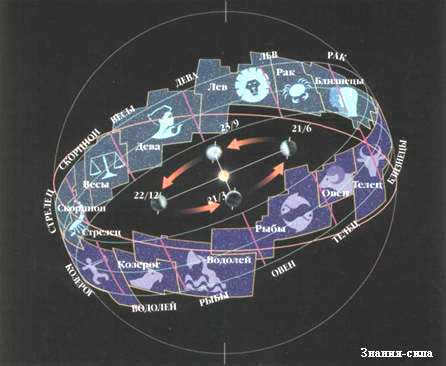

Earth’s revolution around the Sun
When observed from Earth, the Sun appears to move along the ecliptic, passing through the stars and constellations that make up the Zodiac. However, it should be noted that the Sun also traverses the constellation of Serpens, which falls outside of the Zodiacal Circle.
Four Seasons
Seasonal changes occur as a result of the Earth’s orbit around the Sun. The Earth’s axis is tilted in relation to its orbit, causing different amounts of sunlight to reach each hemisphere. In January, the Earth is at its closest point to the Sun (perihelion), while in July it is at its farthest point (aphelion). This tilt causes one hemisphere to tilt towards the Sun, resulting in longer days and higher temperatures during summer. Conversely, in winter, the Sun is lower in the sky and its rays hit the Earth at an angle, leading to shorter days and colder temperatures.
Seasons in the northern hemisphere
Seasons in the northern hemisphere are characterized by distinct changes in weather patterns and temperatures throughout the year. These changes are caused by the tilt of the Earth’s axis and its orbit around the sun.
In the northern hemisphere, there are four seasons: spring, summer, autumn, and winter. Each season has its own unique characteristics and is associated with different weather conditions.
Spring is a time of renewal and growth. It is characterized by warmer temperatures, longer days, and the emergence of new plant life. The weather can be unpredictable, with frequent rain showers and occasional thunderstorms.
Summer is the warmest season of the year, with higher temperatures and longer days. It is a time for outdoor activities and vacations. The weather is typically sunny and dry, although there can be occasional heatwaves and thunderstorms.
Autumn, also known as fall, is a transitional season between summer and winter. It is characterized by cooler temperatures, shorter days, and the changing colors of leaves. The weather can be variable, with sunny and mild days as well as cooler and rainy periods.
Winter is the coldest season of the year, with shorter days and lower temperatures. It is a time for snow and ice, and many outdoor activities such as skiing and ice skating. The weather can be harsh, with snowstorms and freezing temperatures.
Overall, the seasons in the northern hemisphere provide a variety of weather conditions and activities throughout the year. Whether it’s enjoying the beauty of spring flowers, basking in the warmth of summer sun, admiring the colors of autumn leaves, or playing in the snow during winter, each season has its own unique charm.
| Numbers | Phenomena | Zodiac sign | Sunrise | Declination of the Sun |
| March 21 (start of spring) | Vernal Equinox | Aries | 0 hour | 0° |
| June 21-22 (start of summer) | Summer Solstice | Cancer | 6 hour | 23°27′ |
| September 23 (start of fall) | Autumnal Equinox | Libra | 12 hrs. | 0° |
| December 22 (start of winter) | Winter Solstice | Capricorn | 18 hour | -23°27′ |
The annual movement of Earth
Determining the duration of a year, the fundamental unit of time in the calendar, is not as straightforward as it may appear and is contingent upon the chosen point of reference.
The time period in which our planet completes a full revolution in its orbit around the Sun is known as a year. However, the length of a year varies depending on whether the point of reference for measurement is a star located infinitely far away or the Sun.
In the former scenario, it is referred to as the “sidereal year.” This duration is equivalent to 365 days, 6 hours, 9 minutes, and 10 seconds, and signifies the time necessitated for Earth to fully orbit the Sun.
However, if we measure the time it takes for the Sun to appear again at the same point in the celestial coordinate system, such as the vernal equinox, we can determine the length of the “solar year” to be 365 days 5 hours 48 minutes 46 seconds. The difference between the sidereal and solar year is caused by the precession of the equinox points. Each year, the equinoxes (and therefore, sunrises) occur about 20 minutes earlier than the previous year. This means that the Earth orbits a little faster than the Sun, so that it returns to the point of the vernal equinox in its visible motion through the stars.
Since the duration of the seasons is closely connected to the Sun, calendars are based on “the solar year.”
Additionally, astronomy saw the introduction of ephemeris time, which replaced the traditional astronomical time that was determined by the Earth’s rotation relative to the stars. Ephemeris time is a uniformly flowing time that is unrelated to the Earth’s rotation.
– Find out more about ephemeris time in the section: Theories of the Moon’s motion. Ephemeris time.
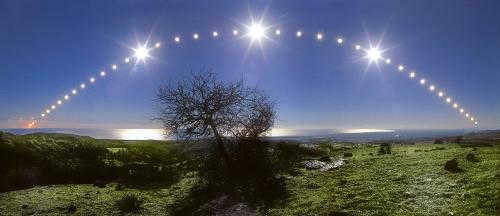
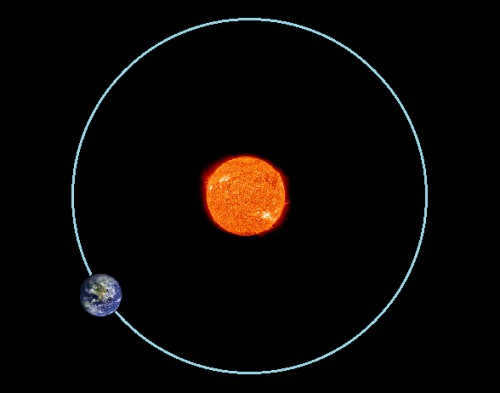
The Earth is a celestial body engaged in the perpetual movement of the cosmos. It spins on its axis, journeys millions of kilometers in its orbit around the Sun, and, along with the entire planetary system, gracefully circumnavigates the center of the Milky Way galaxy. The initial two motions of the Earth are readily observable to its inhabitants through the altering daily and seasonal light, temperature fluctuations, and the distinctiveness of the seasons. Presently, our focus is directed towards the attributes and duration of the Earth’s orbit around the Sun, and its impact on the planet’s existence.
General information
The Earth follows an orbit that is the third farthest from the Sun. The average distance between the Earth and the Sun is 149.5 million kilometers. The total length of the orbit is approximately 940 million kilometers. It takes the Earth 365 days and 6 hours to cover this distance, which is known as a sidereal or sideric year. This is the time it takes for the Earth to complete one orbit around the Sun relative to distant stars. The Earth travels at an average speed of 30 km/s during its orbit.
From the perspective of an observer on Earth, the planet’s revolution around the Sun is evident in the changing position of the Sun in the sky. The Sun moves one degree per day in the eastern direction compared to the stars.
The path of planet Earth in space
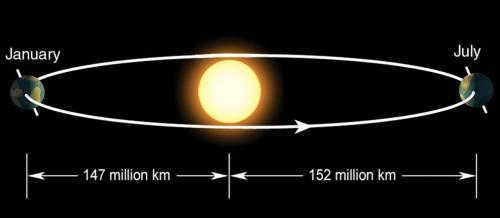

The Earth does not follow a perfectly circular path as it revolves around the Sun. Instead, its orbit is shaped like an ellipse, with the Sun located at one of the foci. This elliptical shape of the orbit causes the Earth to move closer to the Sun at certain points and farther away from it at others. The point at which the Earth is closest to the Sun is known as the perihelion, while the point of maximum distance is called the aphelion. Currently, the Earth reaches its perihelion around January 3rd and its aphelion around July 4th. During this journey, the Earth’s speed is not constant; it accelerates after passing the aphelion and decelerates after overcoming the perihelion.
In January, the two cosmic bodies are separated by a minimum distance of 147 million kilometers and a maximum distance of 152 million kilometers.
Sputnik
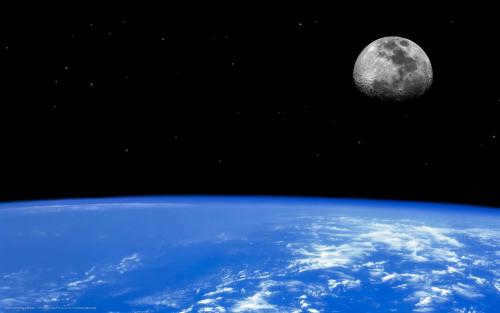
Alongside the Earth, the Moon orbits the Sun. When observed from the north pole, the Moon moves in a counterclockwise direction. The Earth’s orbit and the Moon’s orbit are situated in separate planes, with an angle of approximately 5° between them. This difference significantly reduces the frequency of lunar and solar eclipses. If the orbital planes were identical, one of these events would occur every two weeks.
The Earth’s orbit and the Moon’s orbit are configured in a manner that both objects revolve around a shared center of mass, completing one revolution in approximately 27.3 days. As a result, the Moon’s tidal forces gradually decelerate the Earth’s axial rotation, slightly lengthening the duration of a day.
Implications
The tilt of our planet’s axis in relation to the plane of its orbit has significant consequences for the climate. Throughout the year, this tilt and the Earth’s motion around the sun result in various changes in weather patterns. During the period when the north pole is inclined towards the sun, the sun rises higher in the sky over our region. This leads to longer days and warmer temperatures. Conversely, when the north pole is tilted away from the sun, the warmth is replaced by cooler temperatures. The southern hemisphere experiences similar climate changes.
The change of seasons occurs during the equinox and solstice points, which correspond to specific positions of the Earth’s axis in relation to its orbit. Let’s delve into this topic further.

The solstice is the moment in time when the axis of a planet is tilted to its maximum extent towards or away from the luminary. The Earth’s orbit around the Sun has two such sections. In regions with middle latitudes, the position at which the luminary is directly overhead at noon rises higher and higher each day. This continues until the summer solstice, which occurs on June 21 in the northern hemisphere (the longest day of the year). After the summer solstice, the position of the luminary at noon begins to decrease until December 21-22. These days mark the winter solstice in the northern hemisphere. In middle latitudes, this is the shortest day of the year, after which the days start to lengthen again. In the southern hemisphere, the tilt of the axis is opposite, so the winter solstice falls in June and the summer solstice falls in December.
The equivalence of day and night
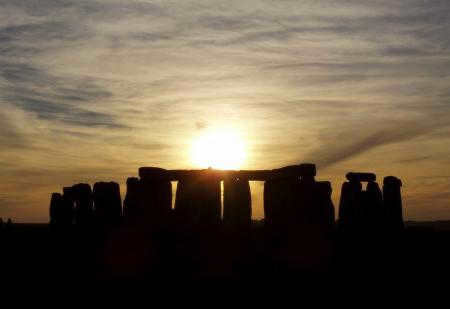
The equinox occurs when the Earth’s axis becomes perpendicular to the plane of its orbit. During this time, the terminator, which marks the boundary between the illuminated and dark halves of the planet, passes directly along the poles, resulting in equal day and night. There are two equinoxes on the Earth’s orbit. The vernal equinox takes place on March 20, while the autumnal equinox occurs on September 23. These dates are applicable to the northern hemisphere. In the southern hemisphere, similar to the solstices, the equinoxes are reversed: the autumn equinox falls in March, and the spring equinox falls in September.
Which region is hotter?
The unique orbital path of the Earth, combined with its axial tilt, has an interesting impact. When the Earth is closest to the Sun, it is the south pole that directly faces the Sun, resulting in summer in the southern hemisphere. During this time, the planet receives 6.9% more energy compared to when it is farthest from the Sun (aphelion). This energy difference is mainly experienced in the southern hemisphere, which receives slightly more solar heat throughout the year compared to the northern hemisphere. However, the overall impact of this discrepancy is minimal, as a significant portion of the “extra” energy is absorbed by the waters of the southern hemisphere.
Tropical and Sideric Year
The duration of the Earth’s revolution around the Sun relative to the stars is approximately 365 days, 6 hours, and 9 minutes, as previously mentioned. This is known as the sideric year. It can be assumed that the change of seasons also occurs within this time frame. However, this is not entirely accurate: the duration of the Earth’s revolution around the Sun does not align with the complete cycle of seasonal changes. Instead, it corresponds to the tropical year, which lasts for 365 days, 5 hours, and 51 minutes. The tropical year is typically measured from one vernal equinox to the next. The slight difference of twenty minutes between the two periods is caused by the precession of the Earth’s axis.

For convenience, it is assumed that there are 365 days in a year. The remaining six and a little hours are accumulated in a day for four revolutions of the Earth around the Sun. To prevent the discrepancy between the calendar and the sideric year from growing, an additional day, February 29, is introduced.
The only satellite of the Earth, the Moon, has some influence on this process. As mentioned before, this influence is manifested in the deceleration of the planet’s rotation. Approximately every hundred years, the length of the day increases by about one thousandth.
The Gregorian calendar
Introduced in 1582, the Gregorian calendar is a familiar way for us to count days. It differs from the Julian calendar in that it allows the “civil” year to align with the full cycle of seasonal changes. This means that the months, days of the week, and dates repeat exactly every four hundred years. The length of the year in the Gregorian calendar is very similar to the tropical calendar.

The reform aimed to restore the customary date of the vernal equinox, which is March 21. Historically, the date of equal day and night shifted to March 10 from the first century A.D. to the sixteenth century. The primary motivation for revising the calendar was the accurate calculation of Easter. It was crucial to keep March 21 closer to the actual equinox for this purpose. The Gregorian calendar effectively accomplishes this task. The shift of the vernal equinox date by one day will not occur until 10,000 years from now.
If we were to compare the calendar and the tropical year, there is a potential for more notable alterations. Due to the idiosyncrasies of the Earth’s movement and the various factors that influence it, a discrepancy of one day in sync with the change of seasons would gradually accumulate over the course of approximately 3200 years. If it were of significance to maintain a rough equivalence between the tropical and calendar year at this point in time, a reform akin to that of the 16th century would once again be necessary.
The length of time it takes for the Earth to complete one revolution around the Sun is associated with various definitions of a year such as the calendar year, the sideric year, and the tropical year. Over the centuries, methods for determining the duration of these years have been refined. Recent discoveries about celestial interactions have allowed for speculation about the future understanding of the term “year” in the next few millennia. The Earth’s revolution around the Sun and its relationship with the changing seasons and the calendar serve as a prime example of how astronomical phenomena have a profound impact on human society, as well as the interconnections within the vast cosmic system.
Rotating around the axis
Our Earth undergoes rotations around its own axis while also moving from west to east. This movement is not perceptible to humans, as we are carried along with it. The consequences resulting from this phenomenon include:
- The alternation of day and night;
- A duration of approximately 23 hours and 57 minutes;
- An angular displacement of 15 degrees;
- A counterclockwise direction;
- A velocity of 1668 km/h at the equator.
Each year, there is a slight decrease in speed by 3 milliseconds, which is closely related to the gravitational force exerted by the Moon (according to preliminary estimations made by astronomers).
Revolution around the Sun
The period of the Earth’s revolution around the Sun is one Earth year, which is equivalent to 365.2565 days according to accurate calculations. In June, the Earth reaches its farthest region from the Sun, known as Aphelion. Conversely, in December, the Earth is closest to the Sun at a point called Perihelion.
It is important to acknowledge the significant influence of the irregular shape of the Earth’s orbit on its velocity parameter when studying the period of its orbit around the Sun. The Earth’s speed reaches 30.28 kilometers per second before slowing down and repeating this cycle indefinitely. The precise maintenance of this cycle is crucial for the existence of all life.
When exploring the Earth’s behavior during its orbit, scientists consider factors such as the gravitational pull of the Moon and the impact of other celestial bodies.

Orbital characteristics of Earth
Main details
Before discussing the duration of Earth’s orbit around the Sun, it is important to examine some related aspects. The reason is that our planet ranks third in distance from the celestial body. Its formation occurred from the elements of a nebula. This event took place approximately 4.55 billion years ago. Throughout its evolutionary development, a unique spherical shape was formed. Equally unique is its orbit, which measures approximately 930 million kilometers in length.
In this way, the Earth completes a complete orbit around the Sun within a span of 1 calendar year. Nonetheless, as a result of the irregular shape of its path, the speed at which our planet travels is significantly affected. During the summer season, it maintains a velocity of 29.28 kilometers per second, but experiences a notable increase in speed once it reaches the maximum velocity of 30.28 seconds in the Perihelion zone. Eventually, the celestial body decelerates and the cycle repeats endlessly. The precise observation of this phenomenon is crucial for all life forms on Earth.
Attention!
When considering the Earth’s orbit around the Sun, it is crucial to consider various significant aspects and factors. The gravitational pull of all celestial objects and the influence of other stars play a particularly important role. Additionally, the trajectory of our moon’s movement is also of great significance.
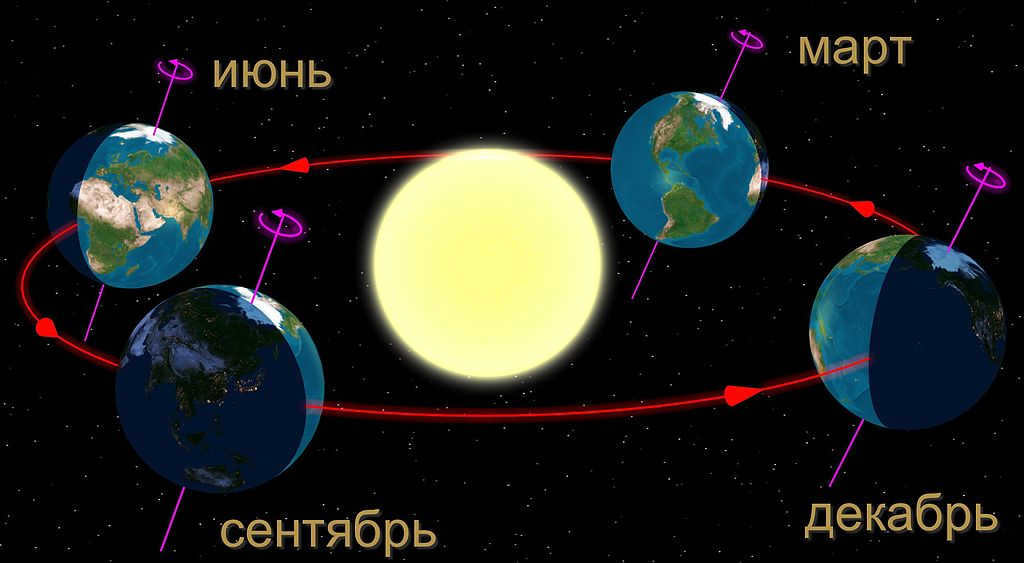
Seasons
The Cycle of Seasons
So, how long does it take for the Earth to complete a revolution around the Sun? The answer is already known. It takes a total of 365 days. During this journey, our planet is also rotating in an eastward direction. Throughout this orbital path, the Earth maintains a constant tilt angle. As a result, a specific hemisphere is always facing the Sun, causing it to experience summer. On the opposite side, the hemisphere that is “turned away” from the Sun, winter prevails. This cyclic motion is responsible for the changing of seasons.
Therefore, in the span of a year, the Earth completes a full orbit around the Sun, experiencing the changing of seasons from winter to spring, summer, and then fall. During two specific moments in this annual cycle, both the northern and southern hemispheres are in sync with each other in terms of the seasonal conditions they are experiencing. This occurs because our planet is positioned in such a way that sunlight is evenly distributed across its entire surface. These occurrences take place during the autumn and spring equinoxes.
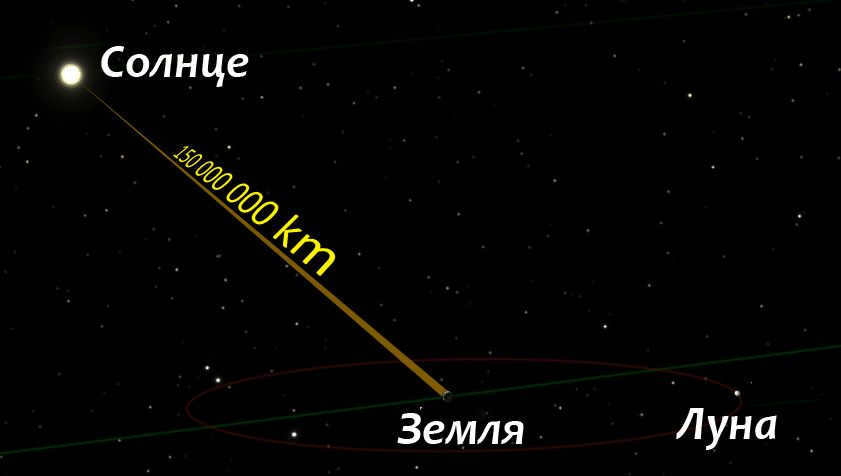
The mean distance between the Earth and the Sun is
Explaining the concept of a leap year
The Earth takes not just 365 days but 365 days and 6.5 hours to complete one revolution around the Sun. Simultaneously, it takes 23 hours and 57 minutes to complete one rotation around its own axis. This creates a discrepancy in time, which is then accounted for. This is why we have leap years, which occur every four years on February 29th. This phenomenon explains the existence of a leap year, which consists of 366 days with an extra day added to February. The Earth’s behavior is influenced by its natural satellite, which exerts a strong gravitational pull. This causes the Earth to slow down its rotation, resulting in longer days: the further away, the longer the day.
The gap separating us from the celestial body
It is evident that the Earth orbits around the Sun, and the duration of this phenomenon is also apparent. Throughout this process, a centrifugal force is generated and subsequently exerts a contradictory push, causing us to move away from the star. There is no observed alteration in velocity. This presents barriers to both falling into the Sun and straying from its entire system. Hence, the trajectory is as precise as possible.
In the present era, researchers have made significant progress in knowledge and calculations. Nevertheless, many questions remain unanswered and necessitate detailed explanation and examination. As a result, scientists are actively involved in research and the development of novel equipment.
The Earth’s Revolution around the Sun and Rotation around its Axis
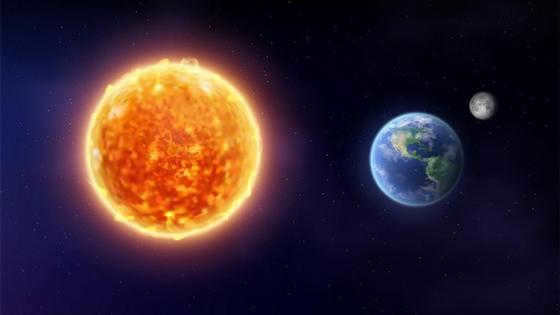
The Earth’s perpetual orbit around the Sun results in the perpetual change of seasons on our planet. As the Earth gracefully orbits the celestial luminary, it also manages to rotate around its axis, causing the transition between day and night. This raises the question of why we don’t perceive this movement and how it occurs. Let us embark on a quest to uncover the answers.
The concept of the geocentricity of the world was first formulated by ancient scientists. It was believed that our planet was a stationary center, with all celestial bodies orbiting around it.
In the 3rd century B.C., the renowned astronomer Aristarchus of Samos proposed the revolutionary idea that the Earth revolves around the Sun. This heliocentric system of the world challenged the prevailing belief at the time.
While this idea was supported by scholars like the Babylonian Seleucus in the 2nd century B.C., Heraclides of Pontus, and Seneca, they were in the minority. Aristotle and Ptolemy, on the other hand, actively argued against it, presenting numerous arguments in favor of the Earth’s immobility in their works.
Explaining Pascal’s Law: its essence and significance in simple terms.
The topic was further explored by medieval writers. Once again, the theory of the Earth’s rotation was put forth by the esteemed Indian astronomer and mathematician Aryabhata (late 5th – early 6th centuries).
A significant development in this debate occurred with the release of the influential work On the Revolutions of the Celestial Spheres, authored and published in 1543 by the astronomer Nicolaus Copernicus, who hailed from Poland and Germany. He successfully provided evidence for the concept of the Earth’s rotation and was able to convince humanity to consider and embrace the heliocentric system of the universe.
Additional experiments were conducted to validate the scientist’s findings, as there were numerous skeptics and opponents of this idea.
It was only after Galileo discovered the principle of motion relativity that the dispute started to calm down. He determined that the Earth’s steady movement does not impact the events taking place on it. The scientist provided an explanation for why we, as inhabitants of the planet, do not perceive any sensation during its continuous motion.
Pythagoras: his life story, achievements, and famous quotes
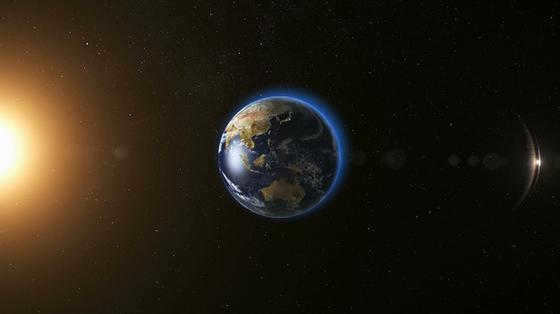
It is common knowledge for the modern human that the Sun is orbited by the Earth. Scientists have uncovered the following details about this process:
- The Earth follows a specific path, or orbit, that spans approximately 930 million kilometers.
- The Earth’s orbit has a speed of approximately 30 km/s, which is equivalent to 107,218 km/h.
- Our planet rotates in an eastward direction.
- During this rotation, the Earth maintains a distance of 150 million kilometers from the Sun.
- It takes the Earth 365 days and 6 hours to complete one full rotation. This period of time is known as a year.
- Every four years, an additional day is added to the calendar. As a result, after three years, February has 29 days.
Corridor of eclipses 2021: what to expect and be cautious of
During the Earth’s rotation, its angle of inclination remains constant. This means that at a certain point in its orbit, the Earth tilts more towards the Sun in the Southern Hemisphere, resulting in the summer season.
Conversely, the North Pole receives less sunlight during this time, leading to winter cold. There are also periods when the Sun shines more evenly on both hemispheres, such as during spring and fall.
The Rotation of the Earth around Its Axis
When we imagine a line connecting the North and South poles of the Earth, we can identify the Earth’s axis. This axis experiences a continuous rotation, which can be described as follows:
The Parade of Planets: Understanding and Anticipating this Phenomenon
- The Earth’s axis is not perfectly vertical. Instead, it is tilted at an angle of 23.5 degrees in relation to the Earth’s orbit.
- The rotation around the axis, just like the orbit, occurs in an eastward direction. If we observe the Earth from above the North Pole, the rotation is akin to the movement against the hands of a clock.
- As this rotation takes place, the transition from day to night occurs.
- The speed of Earth’s rotation near the equator (the line that divides the planet equidistant from both poles and runs around its entire circumference) is 465 m/s (1,674 km/h). As you move away from the equator, the speed of this movement decreases.
The last fact is not widely known, but it is quite interesting. It can be demonstrated clearly in the following manner:
- Quito, a city located near the equator, is inhabited by people who unknowingly move with the planet at a velocity of 465 m/s.
- The residents of Moscow, who live north of the equator line, rotate at almost half the speed. Their velocity is approximately 260 m/s.
Mercury retrograde: everything you need to know about it

Earth and Sun in the Universe: Freepick
Humans are unable to perceive the continuous and consistent rotational motion of the Earth. However, this motion is not static and undergoes changes. Researchers have discovered that the Earth’s rotation experiences an average slowdown of four milliseconds each year.
This phenomenon can be explained by the gravitational pull of the Moon, which influences the ebb and flow of tides on our planet. During tidal events, the Moon attempts to attract water towards itself, causing it to move in a direction opposite to that of the Earth.
This unique counteraction results in the generation of a slight frictional force at the bottom of bodies of water. According to the principles of physics, this process leads to a minor deceleration of the Earth’s velocity.
The dates that mark the extreme points in the rotation process of our planet are as follows:
- Winter Solstice (December 21). On this day, in the region of the South Polar Circle, there is no night. Conversely, the North Polar Circle experiences a day covered in darkness.
- Summer Solstice (June 21). During this time, the opposite occurs: the South Polar Circle is engulfed in night for a day, while the North Polar Circle enjoys a full 24-hour day.
- During the spring equinoxes (March 20) and autumn equinoxes (September 22 or 23, depending on the year), the equator is closest to the Sun, resulting in equal duration of day and night in both hemispheres.
Exploring the possibility of life on Mars: explanations and theories
Why doesn’t the Earth fly off into space and crash into the Sun if it’s constantly moving? The Earth’s rotation creates centrifugal force, which tries to push the planet away from the Sun.
However, this doesn’t happen because the Earth’s movement always maintains the same speed, and the distance to the Sun is carefully balanced with the centrifugal force.
If the Sun didn’t attract the Earth, our planet would wander through the Galaxy. It would fall into its star if it moved at a slower orbital speed. But thanks to the perfect natural harmony of all these forces and velocities, none of these things occur.
Does humanity have a predetermined fate?
For centuries, humanity has been unraveling the laws governing the motion of the Earth around the Sun. Throughout history, people have sought alternative explanations for the phenomena of day and night and the changing seasons. However, it is now firmly established that our planet rotates, and we, as inhabitants, are carried along with it.
An exclusive collection of news curated by our editor-in-chief.
How many complete orbits around the sun has the Earth completed in the 21st century?
The sun’s rays carry warmth. Insects, reptiles, and snakes regulate their body temperature based on the temperature of their environment. The sun heats up the bodies of these creatures, which may have cooled overnight.
As autumn arrives, the Sun provides less warmth to the Earth, resulting in cooler temperatures. Many birds migrate to warmer regions. Animals prepare for winter by storing food or shedding their summer fur for thicker winter coats. Some animals hibernate during the winter months.
During the cold season, plant growth comes to a halt. In the fall, numerous plants shed their leaves. In the spring, when temperatures rise, plant growth and development resume.
The sun is responsible for providing light and heat to all living organisms on Earth. It plays a crucial role in the growth and development of plants, which can be categorized into light-loving and shade-tolerant species.
Questions and assignment
1. What is the significance of the Sun in sustaining life on Earth?
2. How would the absence of the Sun impact our planet?
3. What role does the Sun play in the life cycle of plants?
Which statements are true?
a) Sunlight is essential for plants to produce nutrients;
b) Animals can survive without the presence of plants;
c) The Sun is the primary source of life on Earth.
Units of time
In ancient times, people lacked an understanding of the phenomenon behind the alternation of day and night. They held a deep fear that one evening the Sun would vanish, leaving behind a perpetual cold and darkness.
Eventually, people discovered the explanation for the cycle of day and night.
Let’s review the factors that contribute to the transition between day and night.
Due to the Earth’s rotation on its axis and its orbit around the Sun, we have three distinct units of time: a day, a month, and a year.
During a day, the Earth completes a full rotation on its axis, which is divided into 24 hours.
Over the course of 365 days and 6 hours, the Earth completes one orbit around the Sun. To simplify this, we consider a year to be 365 days. The extra 6 hours accumulate to form a full day, resulting in a leap year with 366 days. This leap year occurs every four years.
As the Earth orbits the Sun, it remains tilted to one side, leading to the changing of seasons. When one hemisphere is tilted towards the Sun, it experiences summer, while the opposite hemisphere experiences winter.
I have observed that the Moon undergoes a transformation in its appearance, transitioning from a slender crescent shape to a complete circle, and at times even vanishes altogether. What is the reason behind this phenomenon?
The Moon orbits around the Earth, and as it does so, different portions of its surface are illuminated by sunlight. When the side of the Moon that is hidden from our view receives sunlight, it becomes nearly invisible in the sky. This particular phase is known as the new moon.
As the Moon reaches the halfway point in its orbit around the Earth, its entire surface becomes illuminated, resulting in the full Moon that we observe. This phase is referred to as a full moon.
Throughout the course of a year, these lunar phases repeat themselves 12 times, leading to the division of the year into 12 months.
The measurement units of time include the day, month, and year.
Questions and tasks
1. Which units of time measurement are associated with the Earth’s rotation?
2. What is the reason for dividing the year into 12 months?
Which statement is accurate?
Select the correct response.
One year corresponds to a complete revolution:
According to belief, the ancient Romans were the ones who came up with the names of the months. Initially, they were simply referred to by numbers: first month, second month, third month… Eventually, the months were given names in honor of heroes, gods, and holidays. For instance, January is named after the god Janus, who is the patron deity of travelers and sailors. March is named after the god of war, Mars, and July is named after the military general and emperor Julius Caesar. In Latin, September means “seventh”, as the ancient Romans counted months starting from March instead of January. December, on the other hand, means “tenth” in Latin.
The term “calendar” originated from ancient Rome. Calends referred to the initial days of each month and were proclaimed in the central square of the city, marking the commencement of a new month. Numerous civilizations devised various calendars.
The initial calendars took on a fascinating form – they were knots on a rope or notches on a stick. By pre-tying a specific number of knots on the rope and subsequently untying one knot per day, individuals could roughly estimate the elapsed time between two events.
The duration of the Earth’s orbit around the Sun captivates many individuals. This phenomenon is crucial as it profoundly influences the Earth’s surface, impacting weather patterns, atmospheric stability, and the state of the biosphere.
Revolution along the Axis
Our planet undergoes rotations around itself and moves in an eastward direction. It goes unnoticed by humans, as we are in sync with its movement. The implications of this phenomenon include:
- The alternation of day and night
- A duration of 23 hours and 57 minutes
- An angle of 15 degrees
- A counterclockwise direction
- A speed of 1668 km/h at the equator
Every year, there is a slight decrease in speed by 3 milliseconds, which is believed to be influenced by the gravitational pull of the moon (according to preliminary evaluations by astronomers).
Orbiting the Sun
One must now consider the duration of the Earth’s orbital revolution around the Sun. It spans a single Earth year. Precise calculations reveal that it lasts for 365.2565 days. Aphelion, the farthest point from the Sun, occurs in June. Conversely, Perihelion, the closest point, occurs in December.
When studying the Earth’s orbit around the Sun, it is crucial to recognize the significant impact of its irregular shape on the velocity parameter. As the celestial body reaches a velocity of 30.28 kilometers per second, it decelerates its trajectory. This cycle repeats indefinitely, and the existence of all life hinges on its precise maintenance.
When it comes to understanding how the Earth behaves in its orbit, scientists consider the gravitational pull of the Moon and the effects of other celestial bodies.

Orbital characteristics of Earth
Exploring the period of Earth’s orbit around the Sun requires an understanding of certain aspects. It is worth noting that our planet is the third farthest from the Sun. It was formed approximately 4.55 billion years ago from elements of a nebula. Throughout its evolutionary development, Earth took on a unique shape, and its orbit stretched over a distance of 930 million kilometers.
Therefore, the Sun’s orbit takes approximately one year to complete. Nevertheless, the irregular shape of the orbit has a substantial influence on the velocity of our planet. In the summer season, it reaches a speed of 29.28 kilometers per second, and then experiences a remarkable acceleration when it reaches the maximum velocity of 30.28 seconds in the Perihelion area. Eventually, the celestial body decelerates and the process repeats endlessly. The entire existence of life on Earth relies on the precise observation of this phenomenon.
Attention!
When examining the Earth’s revolution around the Sun, it is crucial to consider various significant aspects and factors. The gravitational pull of celestial bodies and the impact of other stars play a particularly vital role. The movement pattern of our natural satellite holds utmost importance.

The Cycle of Seasons
So, the Earth completes a revolution around the Sun. How long does this take? The answer is already known. It takes a total of 365 days. Simultaneously, our planet, as previously mentioned, moves in an eastward direction. Throughout this journey, the Earth maintains a consistent angle of inclination. As a result, within a specific orbital region, it always faces a particular side. This period of time is experienced by humanity as summer. On the side that is “turned away” from our star, winter prevails. This repetitive movement is precisely what causes the change of seasons.
Therefore, in the course of a year, the Earth completes a full orbit around the Sun, experiencing the changing seasons of winter, spring, summer, and fall. During two specific points in this cycle, both the northern and southern hemispheres have the same seasonal conditions. This occurs because our planet is positioned in such a way that it receives equal illumination from the Sun across its entire surface. These moments, known as the equinoxes, take place during the transitions from summer to fall and winter to spring.
Also, check out: A 6th-grade essay on the structure of the Earth

The average distance between the Earth and the Sun is…
Explaining the concept of a leap year
The Earth takes approximately 365 days and 6.5 hours to complete one revolution around the Sun. Additionally, it takes about 23 hours and 57 minutes for the Earth to rotate on its own axis. This discrepancy in time results in a few extra hours that need to be accounted for. Every four years, these extra hours are added up and a leap year is created, with an additional day added to the month of February. This phenomenon is influenced by the Earth’s natural satellite, which exerts a strong gravitational force. This force slows down the Earth’s motion, leading to longer days as the distance from the satellite increases.
The gap separating us from the celestial body
It is evident that the Sun is orbited by the Earth, and the duration of this revolution is also well-known. Throughout this celestial phenomenon, a centrifugal force is generated and subsequently exerted, which is paradoxical as it propels us away from the stellar body. No alteration in velocity is observed. This poses hindrances to falling into the Sun and straying from its entire system. As a result, the trajectory remains as precise as possible.
Contemporary researchers have made significant strides in comprehension and calculations. However, numerous queries remain unanswered and necessitate thorough explication and examination. Consequently, scientists are actively involved in research and the development of novel apparatus.
Time and Earth’s Rotation
The Earth is in constant motion, never standing still.
The Earth’s rotation around the Sun is a crucial process that determines the presence of life on our planet. The weather, atmospheric stability, biosphere, and other vital conditions for organisms are all influenced by the Earth’s rotation and its position in the solar system.
Because the Earth revolves around the Sun and also rotates on its own axis, every part of the planet experiences the cyclical change of day and night, as well as the transition between the four seasons.
The Source of Earth’s Rotation
One prevalent hypothesis suggests that the Earth’s rotation originated from the processes that occurred during the creation of the planets. Clusters of interstellar dust accumulated to form planetary embryos, attracting other celestial bodies of various sizes. The collisions with these bodies could have imparted rotational motion to the developing planets. Subsequently, the planets maintained their rotation due to inertia.
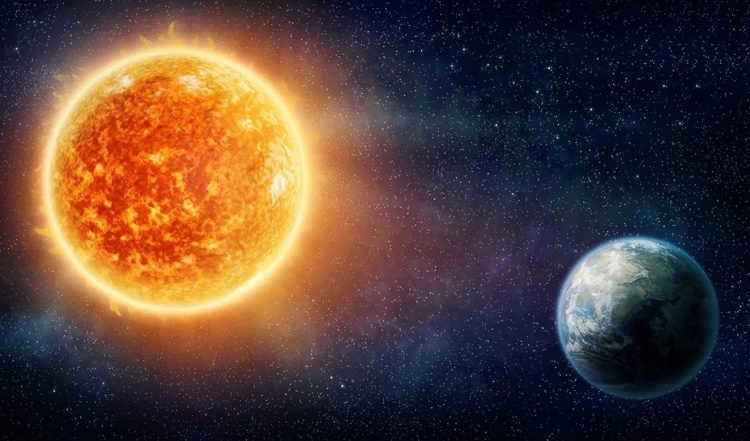
What prevents the Earth from falling into the Sun?
As the Earth orbits the Sun, it generates a centrifugal force that constantly tries to push our planet away. However, this force is balanced by the Earth’s constant speed and its safe distance from the Sun. These factors prevent the Earth from being knocked out of its orbit and falling into the Sun or drifting off into space. Therefore, the Earth continues to follow its designated path.
The Earth spins on its axis
The planet undergoes revolutions around itself in the eastward direction. This process goes unnoticed due to the simultaneous and parallel movement of all objects along with the celestial body. During the Earth’s rotation, only two points, namely the North and South Poles, remain stationary. If these points are connected by an imaginary line, it forms the axis around which the Earth rotates.
The Earth’s axis is inclined at an angle of 23.5° to the Earth’s orbit, rather than being perpendicular.
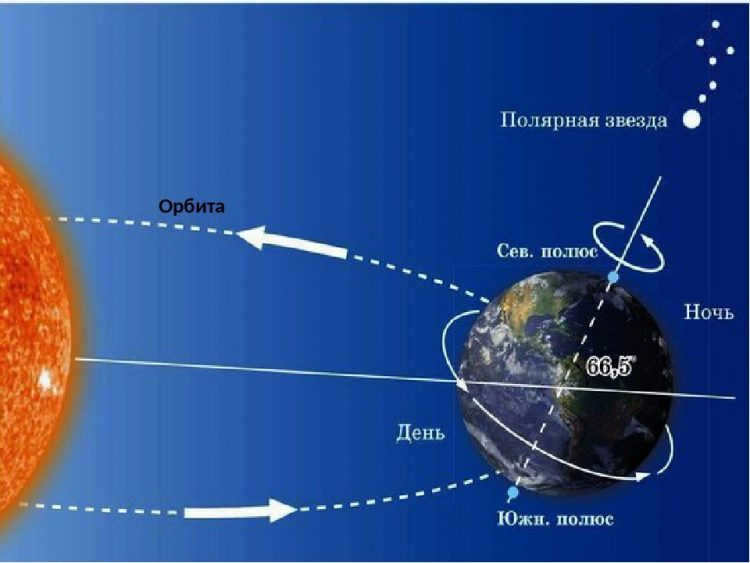
The Earth’s orbit around the Sun
One complete rotation of the Earth is known as a day and lasts for 24 hours, or more precisely, 23 hours 56 minutes and a few seconds. The Earth rotates from west to east. This phenomenon is responsible for the alternating periods of day and night: daytime occurs on the half of the globe that is facing the Sun, while nighttime occurs on the shadow side.
A day is divided into 24 hours (1,440 minutes, or 86,400 seconds) and conventionally divided into four distinct intervals – morning, afternoon, evening, and night.
Calendar days are grouped into weeks, months.
Also read: How to grow violet leaves without roots in soil
The rotation of the Earth has various characteristics and consequences:
- If observed from the North Pole, the planet undergoes counterclockwise rotation.
- The rate of rotation is 15 degrees per hour and remains consistent at any location on Earth.
- The linear velocity of rotation varies across the planet. It is zero at the poles and increases as it approaches the equator. Quito, a city situated near the equator, and its residents imperceptibly move along with the Earth at a speed of 465 m/s. However, Muscovites living significantly north of the equator experience a rotation speed almost half as slow, at 260 m/s.
- At the equator, the rotation speed measures approximately 1668 km/h.
True and average solar time
Local solar time is determined by the position of the Sun. The Earth’s orbit around the Sun is not a perfect circle and the Earth’s axis is tilted, causing variations in true solar time. The difference in the duration of true solar days can be around 50 seconds throughout the year, and the time of the beginning of the day can deviate from its average value by up to 16 minutes.
Accurate local solar time can be determined by measuring the hour angle of the Sun using a specialized astronomical instrument. An approximate estimation of solar time can also be obtained using a sundial, although its accuracy is limited due to shadow blurring.
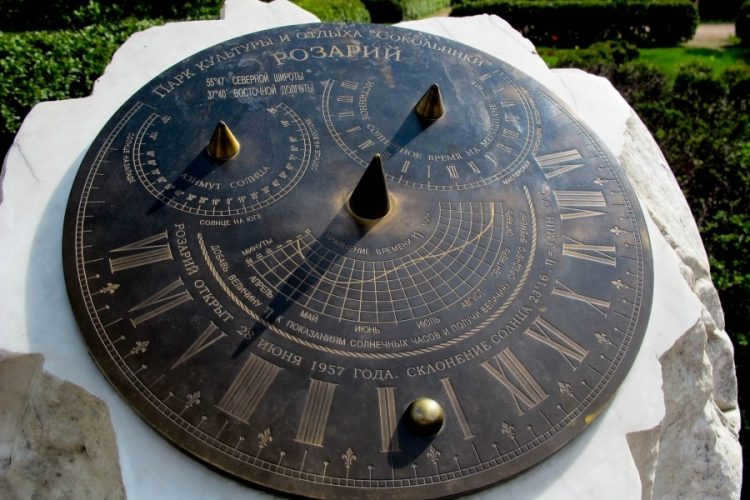
The use of local true solar time was common among the general population until the 18th century. However, as mechanical clocks became more advanced during this time, nations gradually shifted towards the use of mean solar time. This transition took place in Geneva in 1780, London in 1792, Berlin in 1810, and Paris in 1816.
Today, local true solar time is primarily utilized by astronomers, as the introduction of time zones and zone time in the late 19th and early 20th centuries rendered it less relevant for widespread use.
Fascinating piece of information. Researchers have unearthed cycles lasting five years of speeding up and slowing down in the Earth’s rotation on its axis, and every recent “sluggish” year is frequently accompanied by a surge in the quantity of earthquakes worldwide. A direct cause-and-effect link has yet to be unveiled, but these cycles could potentially serve as a means of forecasting the escalation of seismic events.
Earth’s revolution around the Sun
Our planet is the third farthest and the fifth largest celestial body from the Sun. It originated from the constituent elements of the solar nebula approximately 4.55 billion years ago. The planet follows an elliptical path around the central point of our solar system, maintaining an average distance of nearly 149.6 million km from the center, while moving at an average orbital velocity of approximately 29.8 km/sec.
During one complete orbit around the Sun, the Earth manages to complete about 365.25 rotations of its own. This corresponds to the duration of 1 astronomical year.
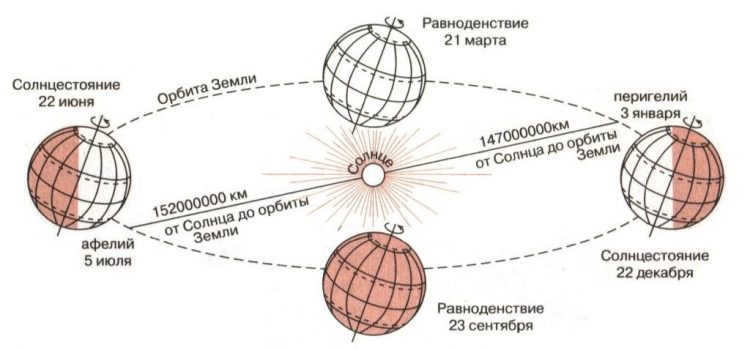
The Earth’s orbit around the Sun
The speed of the Earth’s rotation changes depending on its position in space: when it is closest to the Sun (known as the perihelion), the planet moves at a faster speed – over 30 km/s, while at the aphelion (the farthest point from the Sun), it moves at a slower speed of about 29.3 km/s. The Earth continuously goes through this cycle, and the accuracy of its trajectory is crucial for life on the planet.
As the Earth orbits the Sun, it travels in an eastward direction. Throughout this journey, the Earth maintains a consistent tilt angle, causing one side of the planet to be fully exposed to the Sun during a specific part of its orbit. This period is perceived as summer by the living world. On the opposite side of the planet, which is not facing the Sun during this time, it will be winter. The continuous movement of the Earth results in the occurrence of different seasons.
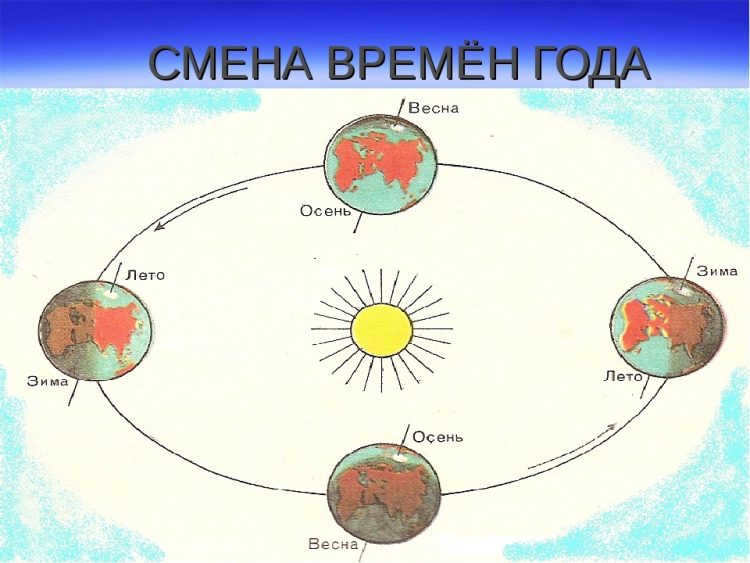
Each year, there are two moments when the Earth experiences the same seasonal conditions in both the northern and southern hemispheres. During these times, the Earth is tilted towards the Sun in a way that allows for even illumination across its surface. These occurrences take place during the autumn and spring equinoxes.
Also check out: A guide on how to properly insulate a water pipe in the ground to prevent freezing.
Leap Year
The Earth completes one rotation around its axis in approximately 23 hours and 56 minutes, while it takes 365 days and 6 hours for the Earth to complete one orbit around the Sun. Due to this slight difference, every four years we add an extra day to the calendar, specifically on February 29th. This year is known as a leap year.
This process is also influenced by the gravitational field of the Moon, which is located in close proximity to the Earth. The Moon’s gravitational pull gradually slows down the Earth’s rotation, causing the day to lengthen by about one thousandth every 100 years.
What does a year represent?
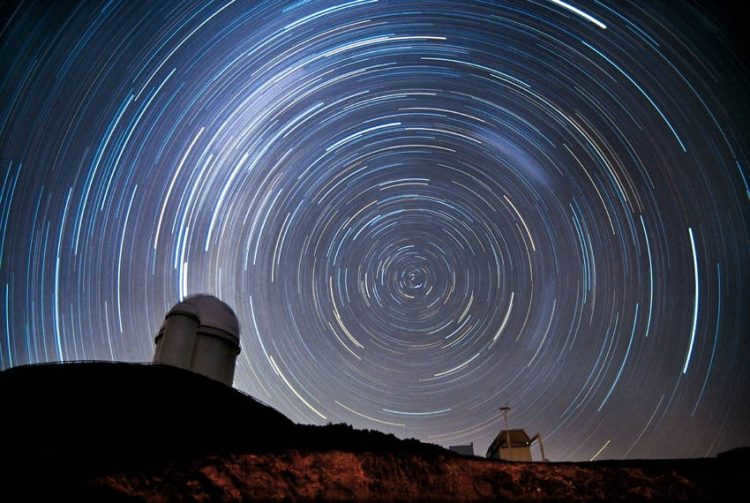
Originally, a year represented a full cycle of seasons (winter, spring, summer, fall). It was only with the development of the heliocentric theory that it became evident that the concept of a year is closely tied to the Earth’s rotation around the Sun (as well as the tilt of the Earth’s axis). In order to enhance the precision of calculating the paths of celestial bodies and addressing other astronomical inquiries, a precise definition of the term “year” was required, leading to several interpretations of the term:
- The tropical year: The period of time in which the Sun returns to its original position on the celestial sphere (from the viewpoint of an observer on the Earth’s surface). Its duration is 365 days 5 hours 48 minutes 45.19 seconds (with slight variations each year).
- Sideric: The duration in which the Earth completes a full revolution around the Sun and returns to its original position (measured relative to the stars, whose position on the celestial sphere changes very gradually). The length is 365 days 6 hours 9 minutes 8.97 seconds.
- An anomalous year: The time span in which our planet returns to a specific point in its own orbit – the pericenter. Duration – 365 days 6 hours 13 minutes 52.6 seconds.
- Calendar year: A period of time that approximates a complete seasonal cycle. Duration 365 days (in the Gregorian calendar).
Date line
The Earth spins on its axis in a westerly to easterly direction. The navigators, under the leadership of Magellan, chose to travel in the opposite direction, circumnavigating the planet from east to west. As a result, they experienced one fewer sunrise than they would have if they had stayed in Europe throughout their journey. To prevent this confusion from happening to future circumnavigators, a line was established – the date line.
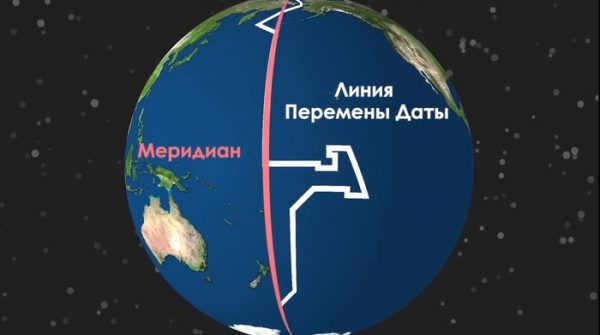
The International Date Line is situated largely along the 180º meridian and serves as the dividing line where the calendar date changes while the time of day remains the same.
For instance, if it’s May 18th to the west of the line, it will still be May 17th to the east. However, the local time will be approximately the same on both sides.
Unlike the Prime Meridian, which runs through Greenwich, England, the International Date Line is mostly located over the ocean. Therefore, when traveling around the world, there is usually no need to add or subtract a day. As mentioned before, the majority of the line coincides with the 180º meridian and connects the North and South Poles, only touching land in Antarctica.
When crossing the International Date Line, adjustments must be made to the calendar. If a ship is moving from east to west, the crew should increase the date by one. Conversely, if the ship is moving in the opposite direction, the date should be decreased. However, when sailing through the region near Oceania, where the time boundary is deviated due to rounding the islands, the crew is only allowed to change the date after crossing the 180º meridian, unless the ship is planning to dock at one of the ports and needs to synchronize with the local time.
Interestingly, crossing the International Date Line in a certain direction can result in experiencing the same day twice. Some people who enjoy romantic gestures may plan their trips to coincide with special occasions such as wedding anniversaries or birthdays.
The date line is essentially a conventional boundary, not based on any physical regularities. Its purpose is to facilitate international communication. Crossing this boundary is similar to adjusting clocks for daylight saving time, allowing humans to align their activities with cosmic processes.
The average distance from the Earth to the Sun is approximately 150 million kilometers. However, due to the Earth’s elliptical orbit around the Sun, its distance varies slightly throughout the year.
This real photo captures the Earth’s movement in a slow-motion, highlighting its rotation on its axis and how it travels relative to other planets and galaxies in a span of 20-30 minutes.
The Variation of Seasons
It is a well-known fact that during the summer, which is the hottest time of the year, in June, the Earth is approximately 5 million kilometers farther away from the Sun compared to the winter season, which is the coldest time of the year in December. Consequently, the change in seasons is not due to the Earth’s proximity to or distance from the Sun, but rather for a different cause.
The Earth maintains a constant axis direction as it orbits the Sun. As the Earth rotates around the Sun, its axis is always tilted to the plane of its orbit. This tilt is the reason for the changing seasons.
On June 22, during the longest day of the year in our hemisphere, the North Pole is illuminated by the Sun while the South Pole remains in darkness. This is because the Sun’s rays do not reach the South Pole. In the Northern Hemisphere, summer brings long days and short nights, while in the Southern Hemisphere, there are long nights and short days. This is due to the oblique angle at which the Sun’s rays reach the Southern Hemisphere, resulting in less heat.
Time differences between day and night
The rotation of the Earth around its axis is responsible for the transition between day and night (more: Scientists on Earth’s rotation). The duration of time differences between day and night depends on the Earth’s rotation around the Sun. During winter, on December 22, the Northern Hemisphere experiences the longest night and shortest day. At this time, the North Pole remains unilluminated by the Sun, existing in a state of darkness, while the South Pole is bathed in sunlight.
In winter, residents of the Northern Hemisphere experience long nights and short days. On March 21-22, day and night are of equal duration, marking the vernal equinox. Similarly, the fall equinox occurs on September 23rd.
During these days, the Earth assumes a specific position on its orbit in relation to the Sun, resulting in the Sun’s rays being able to simultaneously illuminate both the North and South Poles. Additionally, on the equator, the Sun’s rays fall directly overhead, with the Sun positioned at its zenith. As a result, on March 21 and September 23, any location on the Earth’s surface experiences equal periods of daylight and darkness, with 12 hours of illumination from the Sun followed by 12 hours of darkness. This phenomenon is commonly referred to as day equals night on the entire globe.
The presence of various climatic zones on Earth can be attributed to the Earth’s rotation around the Sun. This is because the Earth is a spherical shape and its imaginary axis is always inclined at the same angle to the plane of its orbit. As a result, different parts of the Earth’s surface receive varying amounts of heat and sunlight.
These rays of sunlight hit different areas of the Earth’s surface at different angles, leading to variations in their intensity across the globe. When the Sun is low in the sky, such as during the evening, its rays have a shallow angle of incidence and therefore provide less warmth.
Contrarily, when the Sun is positioned directly overhead (such as at midday), its beams reach the Earth at an elevated angle, thereby enhancing their thermal potency.
The region where the Sun reaches its highest point in the sky on certain days, and its beams fall almost vertically, is known as the hot belt. In these particular areas, various animals have adapted to the scorching climate, such as monkeys, elephants, and giraffes. Moreover, tall palm trees and banana plants thrive, while pineapples ripen to perfection. Providing shade under the tropical sun, the majestic baobab trees stand tall, with trunks reaching a circumference of up to 20 meters.
On the other hand, in the regions where the Sun never rises high above the horizon, two cold belts can be found. These areas have a limited variety of flora and fauna. The animal and plant life here is quite uniform, and large stretches of land are almost barren. Vast expanses are covered in snow. Between the hot and cold belts, there exist two temperate belts, which cover the majority of the Earth’s surface.
The Earth’s rotation around the Sun is responsible for the presence of the five climatic belts, consisting of one hot belt, two temperate belts, and two cold belts.
The hot belt is situated near the equator and is defined by the Tropic of Cancer in the north and the Tropic of Capricorn in the south. The cold belts are marked by the northern and southern polar circles, where polar nights endure for nearly six months and the length of the days remains constant.
While there is no distinct boundary between the hot belts, there is a gradual decrease in temperature from the equator towards the North and South Poles. The regions surrounding the poles are dominated by expansive ice fields, with massive icebergs floating along their inhospitable coastlines (learn more: Floating ice).
For a long time, the dream of reaching either the North or South Pole has captivated the human imagination. Brave and resilient explorers of the Arctic have made numerous attempts to achieve this feat. One such explorer was Georgy Yakovlevich Sedov, a Russian who, in 1912, organized an expedition to the North Pole aboard the ship “St. Foka”.
Unfortunately, the Tsarist government showed little interest in this ambitious endeavor and failed to provide adequate support to Sedov, despite his bravery and expertise as a sailor and traveler. Due to lack of funds, Sedov was forced to spend the first winter on Novaya Zemlya and the second on Franz Josef Land.
In 1914, Sedov, along with two companions, made one final attempt to reach the North Pole. However, his health and strength deteriorated along the way, ultimately leading to his untimely death in March of that same year.
On multiple occasions, large expeditions were outfitted with ships in an attempt to reach the North Pole. However, even these well-equipped expeditions were unable to achieve their goal. The ships were hindered by thick ice, which often caused them to become trapped or even destroyed, resulting in them being carried far off course by the drift of the ice.
It wasn’t until 1937 that a Soviet expedition successfully reached the North Pole using air ships. The brave team consisted of astronomer E. Fedorov, hydrobiologist P. Shirshov, radio operator E. Krenkel, and seasoned sailor I. Papanin, who served as the expedition leader. They lived on a drifting ice floe for a remarkable 9 months. Throughout their journey, the massive ice floe would occasionally crack and collapse, posing further challenges to their survival.





